VENEZUELA
1896 Miranda map
Genuine/Original
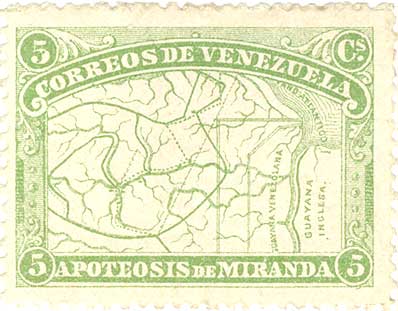
Reprint-forgeries of this issue abound but there is not much helpful
information available on how to sort out the genuine ones. It is difficult because
original stones were used as transfer stones to produce the new unofficial
printing stones.
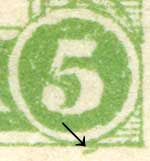 In his excellent book Focus on Forgeries Tyler was able to point out a
reliable distinction for one of the five values, the 5 c.
In the original printing stone there was a constant flaw below the 5 at
right: a short scratch
that was not reproduced in the Barcelona reprinting stone. Of my 5 c
stamps of all kinds, 60 p.c. show this feature. Tyler notes
that there are no useful distinctions in gum and paper. Of my total sample
of random Miranda stamps, 60 p.c. appear to be
originals.
In his excellent book Focus on Forgeries Tyler was able to point out a
reliable distinction for one of the five values, the 5 c.
In the original printing stone there was a constant flaw below the 5 at
right: a short scratch
that was not reproduced in the Barcelona reprinting stone. Of my 5 c
stamps of all kinds, 60 p.c. show this feature. Tyler notes
that there are no useful distinctions in gum and paper. Of my total sample
of random Miranda stamps, 60 p.c. appear to be
originals.
Reprint-forgeries
Only Serrane (The Serrane Guide, APS) dares to give some general detection
assistance. It is based on the essential fact that the printing of the genuine
stamps was better executed. But occasionally the reprints were not so
badly made, and the originals not as finely made as usually. The 1 b and 50 c
denominations are particularly difficult.
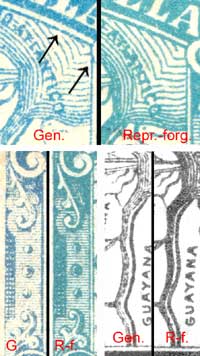 In my opinion Serrane's most helpful
advice is: the river is formed with two thick lines, while it is made of
several lines in the genuine stamps. He also says that a shading line
("wave") in the reprint's inner right corner is touching top and
right. That may be hard
to understand but is explained in the image here. Comparing the left frame
is also helpful, he alleges.
In my opinion Serrane's most helpful
advice is: the river is formed with two thick lines, while it is made of
several lines in the genuine stamps. He also says that a shading line
("wave") in the reprint's inner right corner is touching top and
right. That may be hard
to understand but is explained in the image here. Comparing the left frame
is also helpful, he alleges.
But, really, how can one expect to find relevant
differencies in the very designs of an original and its reprint? In
this
image a semitransparent scan of a genuine 5 c stamp has been laid over a
reprint 1 b. As you can see there is no real difference. Unfortunately
detecting thus relies heavily on the general appearence.
The perforation is the same as in the originals, 12, not 11˝. The colour
shades of both the genuine and reprint-forgeries varies. Genuine 25 c can
also be found in orange. No
tęte-bęches are genuine.
Forgery 1
 What Serrane calls the Geneva forgeries (i.e. Fournier's) seems in reality
to be the Barcelona reprint-forgeries described above. These stamps are
not included in the Fournier Album (the forgeries were sold out by that
time), but they are in his price list from e.g. 1914. There is, however,
also an obvious but uncommon real forgery, and it is perforated 11˝. Out of my
stamps of all kinds only two are forgery 1s (10 c,
25 c). Fournier may have been
marketing both.
What Serrane calls the Geneva forgeries (i.e. Fournier's) seems in reality
to be the Barcelona reprint-forgeries described above. These stamps are
not included in the Fournier Album (the forgeries were sold out by that
time), but they are in his price list from e.g. 1914. There is, however,
also an obvious but uncommon real forgery, and it is perforated 11˝. Out of my
stamps of all kinds only two are forgery 1s (10 c,
25 c). Fournier may have been
marketing both.
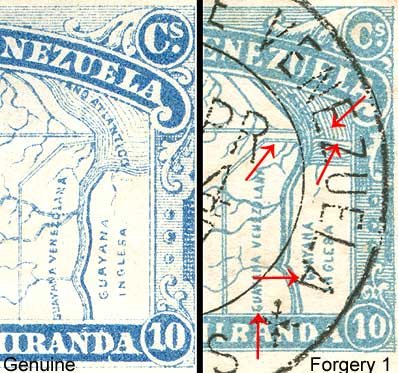 Forgery 1 is easy to detect due to several obvious
errors in the design, cf. the above image. The height is only 23.5 mm
instead of 25 mm.
Forgery 1 is easy to detect due to several obvious
errors in the design, cf. the above image. The height is only 23.5 mm
instead of 25 mm.
Postmarks
The postmarks can be a helpful distinguishing factor. A common forged or
CTO-datestamp is Correos de
Venezuela JUL 18 1896 Puerto Cabello (picture),
which I have only seen on genuine stamps. Please note that there is a typo in APS' The
Serrane Guide. The date is not 12 ENE 97, but the 13th.
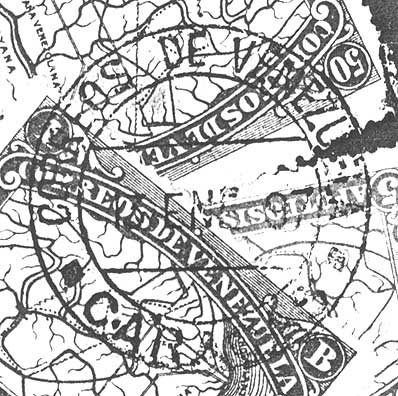 Serrane has
got it right in his original French language work. The ink is black, sometimes
violet. That postmark, which is attributed to Fournier, is found only
on the reprint-forgeries. Some of them is by the way cancelled 5 DIC 85! Forgery 1 seems to be
cancelled by entirely different, very good looking central postmarks. Serrane has
got it right in his original French language work. The ink is black, sometimes
violet. That postmark, which is attributed to Fournier, is found only
on the reprint-forgeries. Some of them is by the way cancelled 5 DIC 85! Forgery 1 seems to be
cancelled by entirely different, very good looking central postmarks.
© G. Kock, www.filatelia.fi |